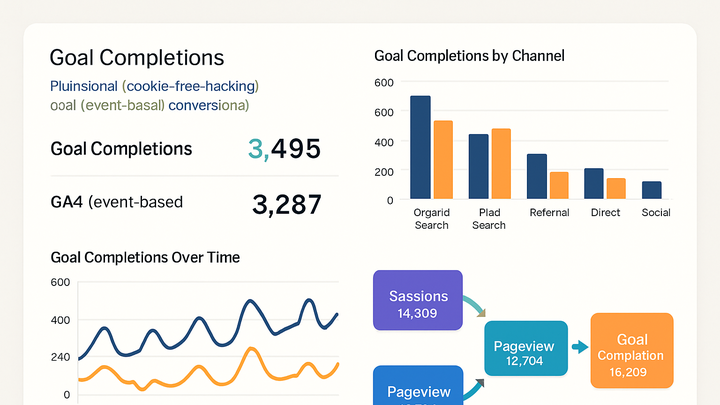Published on 2025-06-22T03:26:28Z
What is a Goal? Examples of Goals in Analytics
Goal in analytics defines a specific user action or outcome you want to track, such as a purchase, sign-up, or content download. Setting up goals allows you to measure how effectively your website or app fulfills your objectives by translating user interactions into quantifiable metrics. Goals provide insight into conversion rates, user engagement, and the performance of marketing campaigns.
This article explores the different types of goals, shows how to implement them with PlainSignal (a cookie-free analytics tool) and Google Analytics 4 (GA4), and outlines best practices for reliable goal tracking.
Goal
A Goal is a predefined user action or conversion metric in web analytics used to measure success against objectives.
Understanding Goals in Analytics
Goals translate strategic objectives into measurable metrics, enabling teams to track user behavior that directly contributes to business outcomes. By mapping a user journey to a specific action—like form submissions or product purchases—you can evaluate the effectiveness of your site or app features.
Well-defined goals help you focus on the interactions that matter most and optimize your funnel accordingly.
-
What is a goal?
A goal is a preconfigured event or threshold representing a key user interaction, such as visiting a thank-you page or triggering a JavaScript event.
-
Why goals matter
Tracking goals connects user behavior to business KPIs, clarifies campaign ROI, and guides product or marketing decisions based on real data.
Types of Goals
Different goal types capture varied user actions. Choosing the right type ensures you measure exactly what’s important to your objectives.
-
Destination goals
Triggered when users reach a specific URL (e.g., a thank-you page after form submission).
-
Event goals
Based on custom events like button clicks, video plays, or downloads, defined by event category, action, or label.
-
Duration goals
Count sessions that last longer than a specified time threshold, indicating deeper engagement.
-
Pages/screens per session goals
Fire when a user views a minimum number of pages or screens in one session.
Implementing Goals with PlainSignal
PlainSignal offers a lightweight, cookie-free way to track user events and define goals without compromising privacy.
-
Adding the PlainSignal snippet
Place the following snippet in your site’s
<head>to start collecting analytics:-
Html snippet
<link rel="preconnect" href="//eu.plainsignal.com/" crossorigin /> <script defer data-do="yourwebsitedomain.com" data-id="0GQV1xmtzQQ" data-api="//eu.plainsignal.com" src="//cdn.plainsignal.com/plainsignal-min.js"></script>
-
-
Configuring goals in PlainSignal
- Log into PlainSignal Dashboard.
- Navigate to Goals tab.
- Click Add Goal, choose event criteria (e.g., click, URL match), and save.
Implementing Goals with Google Analytics 4 (GA4)
GA4 uses an event-based model where any tracked event can be marked as a conversion goal.
-
Enable enhanced measurement
In GA4 Admin > Data Streams, toggle Enhanced Measurement to auto-track pageviews, scrolls, outbound clicks, and more.
-
Mark events as conversions
- Go to Configure > Events.
- Find the event you want to track as a goal.
- Toggle Mark as conversion. GA4 will start reporting it under Conversions.
Best Practices for Goal Tracking
Accurate goal tracking depends on clear definitions, regular audits, and alignment with business metrics.
-
Define smart goals
Ensure each goal is Specific, Measurable, Achievable, Relevant, and Time-bound to drive actionable insights.
-
Align goals with kpis
Map each goal to a high-level KPI so that your analytics reflect real business impact.
-
Regular audits
Periodically verify that goals fire correctly, update criteria as your site evolves, and remove obsolete goals.
